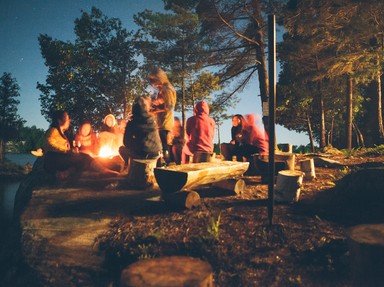Quiz Answer Key and Fun Facts
1. A good way to start your preparation for a camping trip is to have the right clothing. There are several types of clothing you might have on both a warm-weather camping trip and a cold-weather camping trip. Which one of these items would not be on both lists?
2. On a cold-weather camping trip, there is a danger that you or one of your fellow campers could suffer from hypothermia. Which of the following is not a recommended part of first aid procedures for treating hypothermia?
3. Dehydration is another problem that you could encounter when on a camping trip. What is not a good first aid procedure to use with a fellow camper who is suffering from dehydration?
4. A good sleeping bag is the foundation for a good night's sleep when you are camping. Two types of sleeping bags are those with synthetic insulation and those with goose down insulation. Which of these is NOT an advantage that synthetic insulation bags have over goose down insulation bags?
5. You have your gear and have arrived at camp. Now you have to decide where to pitch your tent. Which of the following would NOT be a good suggestion for where to pitch your tent?
6. While camping you may need to use some water at the site and will want to purify it. While boiling the water is one method, it has some disadvantages. What is NOT a potential problem with boiling water?
7. On a camping trip, you may have the occasion to use a topographic map which shows the "relief" of the area. By definition, what is this map showing?
8. Along with using a topographic map, you may also use a compass when hiking to your campsite. Consider that you are using a compass while answering this question. Which of these statements is not true?
9. Tents only go back to the late 19th century when camping became a popular recreational activity.
10. You've come to the end of your camping trip and you want to leave the campsite in good order. Which of these is NOT a good principle?
Source: Author
bernie73
This quiz was reviewed by FunTrivia editor
Bruyere before going online.
Any errors found in FunTrivia content are routinely corrected through our feedback system.


